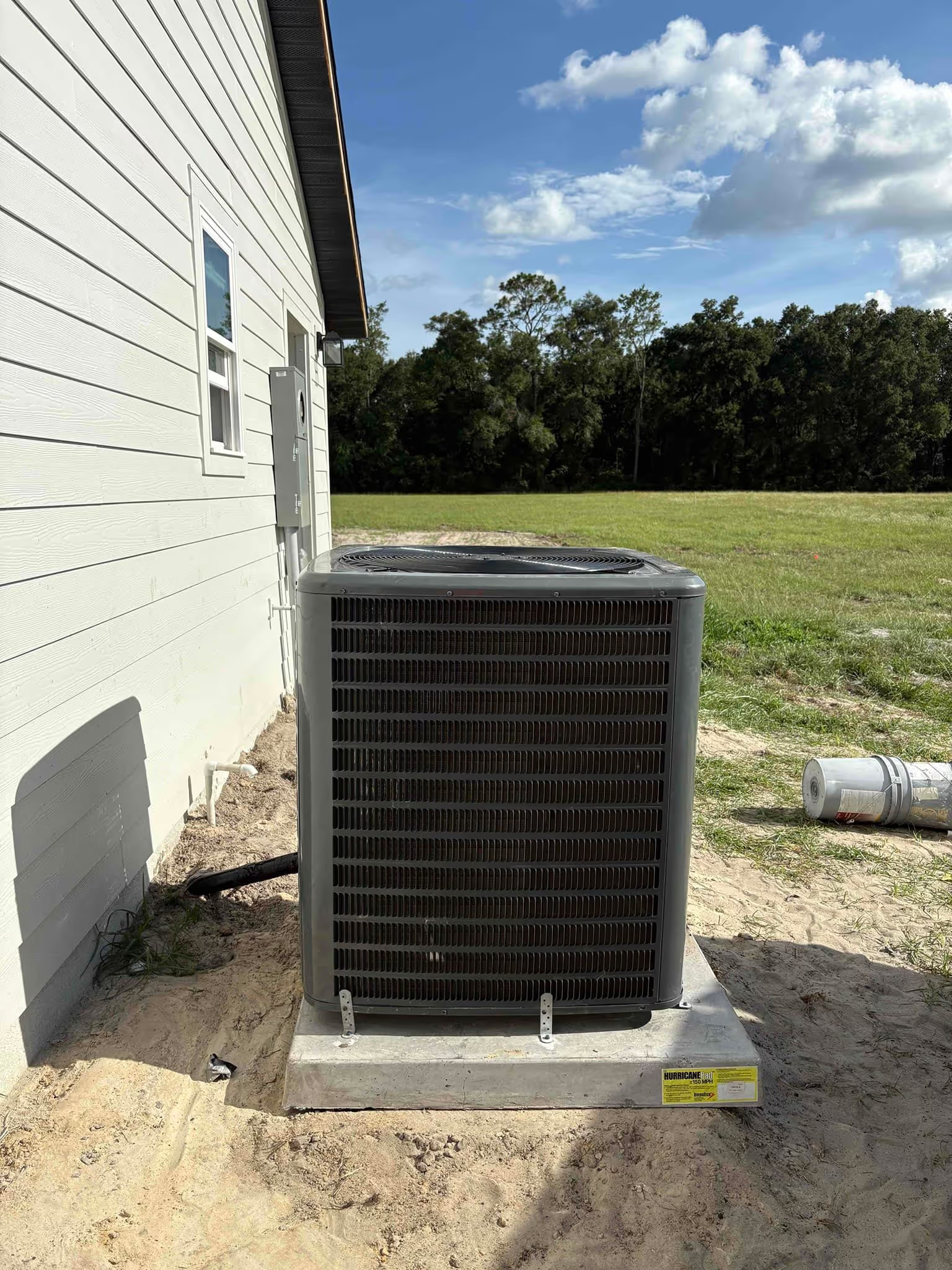


FREE Water Heater
With every whole house repipe purchase. Free brand-new water heater or credit towards a tankless water heater.
.svg)
.svg)
.svg)
.svg)



With every whole house repipe purchase. Free brand-new water heater or credit towards a tankless water heater.
.svg)
.svg)
.svg)
.svg)

Florida's year-round heat and humidity create unique challenges for air conditioning systems that homeowners rarely face in other states. The combination of intense sun, salty coastal air, and constant system use means AC units work harder and face different problems than units in cooler climates.
According to the U.S. EIA, air conditioning accounted for about 19% of total residential electricity consumption in 2020, a clear reminder of how critical efficient repairs and maintenance are to managing utility costs.
Most Florida AC problems stem from the state's harsh environment, requiring specialized knowledge and faster response times than typical HVAC issues. Salt air corrodes components faster near the coast. High humidity causes different types of system strain. These factors mean that choosing the right repair service becomes critical for long-term system health.
The difference between a quick fix and a major replacement often comes down to recognizing problems early and working with technicians who understand Florida's unique climate challenges.
In this article, you’ll learn how AC repair in Florida differs from other states, including costs, emergency rules, and climate-specific maintenance strategies.
Let’s break down the key points you should consider.
Keep reading! Understanding Florida-specific AC issues, emergency situations, and cost expectations helps homeowners make better decisions when their cooling system fails.
Florida's extreme climate creates unique challenges that don't exist in other states. Coastal salt
corrodes parts faster while year-round heat and humidity put constant stress on AC systems.
Salt air near Florida's coastlines creates serious problems for AC units. The salt particles travel inland and coat condenser coils with a corrosive layer.
This buildup reduces heat transfer efficiency. The coils can't release heat properly, forcing the system to work harder and use more energy.
Metal components suffer the most damage:
Year-round AC use in Florida means no rest period for equipment. Most states give their systems a break during cooler months. Florida systems run almost continuously from March through November.
This constant operation wears out moving parts faster. Compressors, fan motors, and contactors fail more frequently than in temperate climates.
High humidity creates more condensation inside AC units. A typical Florida system removes several gallons of water daily from indoor air.
The condensate drain system handles this moisture load. When drains get clogged with algae or debris, water backs up quickly.
Common humidity-related problems include:
Small clogs become major leaks within hours during peak humidity. The drain pan fills up faster than in dry climates, leaving little time to catch problems.
Humidity also creates ideal conditions for mold and bacteria growth. These organisms can block drains and create health hazards if not addressed promptly.
Florida AC systems require different maintenance schedules than systems in other climates. Standard annual service isn't enough for these harsh conditions.
Critical maintenance items need more frequent attention:
Coastal properties need monthly coil rinses during peak salt exposure. This prevents heavy buildup that reduces efficiency and causes premature failure.
Indoor humidity levels should stay between 30-50% for optimal system performance. Dehumidification equipment may be necessary in extremely humid areas.
Regular inspections catch small problems before they become expensive repairs. Florida's climate doesn't give homeowners much time between minor issues and major breakdowns.
Florida's hot climate and frequent storms create specific AC issues that homeowners can often identify and address with basic troubleshooting steps. Understanding short cycling patterns and storm-related problems helps prevent costly repairs.
Check the air filter first. A dirty filter blocks airflow and reduces cooling power. Replace filters every 30-60 days in Florida due to high humidity and dust.
Look at the thermostat settings. Make sure it's set to "cool" and the temperature is below the current room temperature. Check if batteries need replacement.
Examine outdoor unit conditions. Clear debris, leaves, and vegetation from around the condenser. The unit needs at least 2 feet of clearance on all sides for proper airflow.
Inspect circuit breakers. Both indoor and outdoor units have separate breakers. Reset any tripped breakers and wait 30 minutes before testing the system again.
Feel the air coming from vents. Weak airflow often means blocked ducts or a failing blower motor. Strong but warm air usually points to refrigerant or compressor issues that need professional repair.
Air conditioners need 3-5 minutes between cycles to protect internal components. Short cycling means the unit turns on and off too quickly, usually every 1-2 minutes.
Why short cycling damages systems:
Common causes in Florida homes:
Quick diagnostic steps: Time how long your AC runs before shutting off. Count the minutes between restart cycles. If either time is under 3 minutes, the system needs professional attention.
Refrigerant leaks and electrical problems require licensed technicians. However, checking filters and thermostat placement can solve some short cycling issues immediately.
Turn off AC power before storms arrive. Switch off the main breaker and thermostat to prevent electrical damage from power surges and lightning strikes.
Install whole-house surge protection. Standard power strips don't protect large appliances. Whole-house systems guard against voltage spikes that damage compressors and control boards.
Secure outdoor units properly. Check that condensers sit level on concrete pads. Remove loose items like patio furniture that could become projectiles in high winds.
Post-storm inspection checklist:
Wait 24 hours after flooding before running AC systems. Water in electrical components causes dangerous shorts and expensive repairs.
Reset breakers only after inspecting for visible damage. If water entered the outdoor unit, call a technician before attempting to restart the system.
Florida homeowners face unique AC repair costs due to year-round usage and humid conditions. The $5000 rule helps determine when repairs make financial sense versus replacement.
ENERGY STAR estimates that properly installed high‑efficiency HVAC systems can reduce heating and cooling costs by up to 20% per year.
AC repairs in Florida typically range from $150 to $1,200 depending on the problem. Simple fixes like thermostat issues cost around $150 to $300.
More complex problems cost significantly more. Compressor replacements run $1,500 to $2,500. Evaporator coil repairs range from $600 to $1,200.
Several factors affect repair costs in Florida:
Hurricane damage and salt air corrosion also drive up repair costs along coastal areas. Emergency weekend or holiday service calls add $100 to $200 to any repair.
The $5000 rule uses a simple math formula. Multiply your AC unit's age by the estimated repair cost.
If the result exceeds $5000, replacement usually makes more sense than repair. This rule balances repair costs against the unit's remaining useful life.
Example calculations:
The rule works because older units need frequent repairs. A 10-year-old AC that needs a $600 fix today will likely need another expensive repair within two years.
This formula helps homeowners avoid throwing good money after bad on aging equipment.
New AC units in Florida cost $4,500 to $8,500 installed for most homes. A 1,500 square foot house typically needs a 3-ton unit costing $6,000 to $7,500.
Higher efficiency units cost more upfront but save on electric bills. SEER 16 units cost about $1,000 more than SEER 14 models but reduce cooling costs by 12%.
Florida replacement costs by home size:
Replacement makes financial sense when repair costs exceed 50% of a new system's price. For a $7,000 replacement, any repair over $3,500 suggests replacement.
Florida's year-round AC usage means new units pay for themselves faster through energy savings and avoided repair costs.
A broken AC becomes an emergency in Florida when indoor temperatures reach 85°F or higher, especially if vulnerable people like children or elderly adults are present. Emergency repair services are available 24/7 across the state to handle these critical situations.
Indoor temperatures of 85°F or higher signal a true AC emergency in Florida. These temperatures pose serious health risks, particularly for children, elderly residents, and pets who cannot regulate body temperature as effectively.
Signs that require immediate emergency repair include:
Vulnerable populations face the greatest risk during AC failures. Infants under 12 months cannot regulate body temperature well. Adults over 65 have reduced ability to cool down naturally.
People with chronic conditions like heart disease or diabetes need consistent cool temperatures. Pet owners should watch for excessive panting or lethargy in animals.
Emergency services become essential when the AC fails overnight or on weekends. Many Florida HVAC companies offer 24/7 emergency repair specifically because of the state's dangerous heat levels.
Ceiling fans and portable fans provide the most immediate relief while waiting for repairs. Place fans in windows to pull hot air out and draw cooler air in during evening hours.
Create cross-ventilation by opening windows on opposite sides of the house when outdoor temperatures drop below indoor levels. This typically works best after sunset.
Close all blinds and curtains during daylight hours to block heat from entering. Focus especially on south and west-facing windows that receive direct sunlight.
Use these cooling strategies:
Ice and cold water can provide temporary relief. Place bowls of ice in front of fans to create makeshift air conditioning. Freeze water bottles to use as cooling packs.
Consider staying with friends, family, or in public places like shopping malls or libraries if the house becomes too hot. Many communities open cooling centers during extreme heat events.
Emergency HVAC technicians arrive equipped to diagnose and fix most common AC problems on the first visit. They carry replacement parts for frequent failure points like capacitors, contactors, and fuses.
The initial assessment covers electrical connections, refrigerant levels, and mechanical components. Technicians check the thermostat, air filters, and ductwork for obvious problems.
Common emergency repairs include:
Problem
Typical Fix
Time Required
Blown capacitor
Part replacement
30-60 minutes
Refrigerant leak
Seal leak, add refrigerant
1-2 hours
Clogged drain
Clear blockage
30 minutes
Faulty thermostat
Replace unit
45 minutes
Emergency visits cost more than regular service calls. Most companies charge premium rates for after-hours, weekend, and holiday repairs. The higher cost reflects the urgency and immediate availability of skilled technicians.
Temporary solutions may be implemented if full repairs cannot be completed immediately. This might include partial system restoration or portable cooling units while waiting for specific parts.
Emergency technicians prioritize getting some cooling restored quickly rather than completing perfect repairs. They will schedule follow-up visits for comprehensive maintenance once the immediate crisis passes.
Working with skilled Florida AC repair services prevents ongoing problems and saves money over time. Professional HVAC experts provide comprehensive maintenance plans and demonstrate their reliability through their answers to key questions.
Quality HVAC repair and maintenance plans in Florida include regular system inspections and preventive care. Most plans cover bi-annual visits where technicians check refrigerant levels, clean coils, and inspect electrical connections.
Standard maintenance plan features:
Florida's humidity creates unique challenges for AC systems. Professional maintenance plans address these specific conditions by focusing on moisture control and mold prevention.
Many HVAC experts Florida offer priority scheduling for plan members. This means faster service during peak summer months when AC failures are most common.
Maintenance plans typically cost $150-$300 annually. This investment often prevents major repairs that can cost $500-$2,000 or more.
Asking the right questions helps identify trustworthy HVAC repair Florida companies. Professional technicians provide clear answers and explain their processes without pressure tactics.
Key questions to ask:
Reliable companies explain their diagnostic process clearly. They should describe how they identify problems and why specific repairs are needed.
Ask about their experience with Florida's climate challenges. Quality providers understand humidity issues and salt air corrosion in coastal areas.
Request references from recent customers. Established companies readily provide contact information for satisfied clients who can verify their work quality.
Emergency AC failures require immediate attention in Florida's heat. Many HVAC repair services offer 24-hour emergency response with skilled technicians available year-round.
Professional inspection involves checking all system components systematically. Technicians test airflow, measure temperatures, and identify worn parts that could cause future failures.
Emergency service typically includes:
After repairs, technicians can establish ongoing maintenance schedules. This proactive approach prevents repeat breakdowns and extends equipment life significantly.
Many Florida AC repair services offer financing options for major repairs. This helps homeowners address urgent problems without delaying necessary fixes due to cost concerns.
Florida homeowners face unique AC challenges due to the state's hot, humid climate. Regular maintenance and prompt repairs keep cooling systems running efficiently when they're needed most.
Repair costs in Florida typically range from $150 to $1,200 depending on the issue. Simple fixes like filter changes cost less than major component replacements.
Homeowners can handle basic maintenance tasks themselves. Checking filters, cleaning vents, and monitoring system performance help prevent costly breakdowns.
Professional technicians should handle complex repairs involving electrical components, refrigerant, or major system parts. These repairs require special tools and training to complete safely.
Getting a second opinion makes sense for expensive repairs. This helps ensure accurate diagnosis and fair pricing.
Regular maintenance contracts often provide better value than emergency repair calls. Many Florida AC companies offer seasonal tune-ups and priority service.
Older systems may benefit more from replacement than repeated repairs. Energy-efficient models can lower utility costs while providing better comfort in Florida's demanding climate.
Smart homeowners prepare for AC issues before they happen. Building relationships with trusted repair companies ensures faster service when problems occur.
Schedule your Florida AC repair or maintenance visit today to prevent breakdowns, control energy costs, and stay comfortable in the state’s demanding climate.